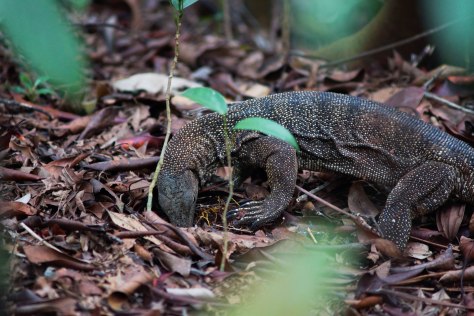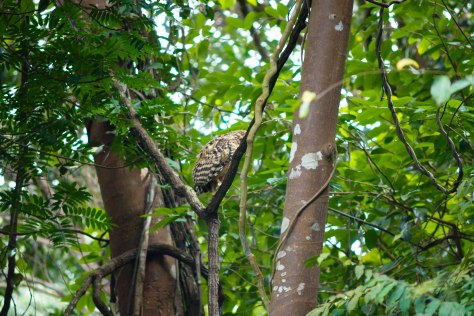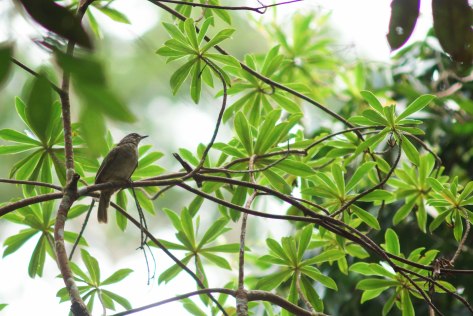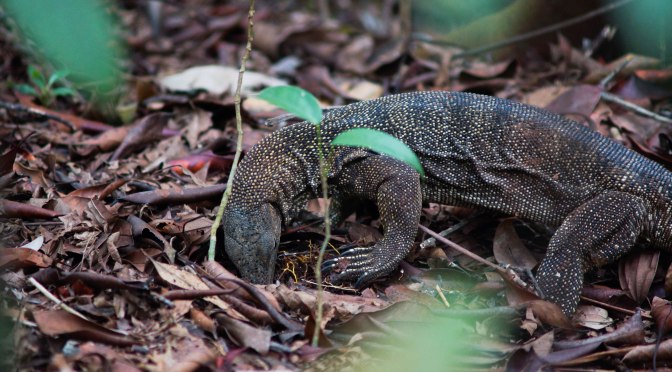It’s been a pretty wild summer and we just had another great walk last week along the Petai Trail. It was pretty awesome to talk with so many interested Singaporeans about the natural heritage we can find at the Central Catchment Nature Reserve (CNNR).

As you can probably guess from the title, the theme for this post was inspired by the cool reptiles we managed to spot along the way.

This critter digging his snout into the ground is most commonly known as the Malayan water monitor (Varanus salvator). Among the largest lizards in the world, you can probably spot this lumbering reptile in areas with dense forest like CNNR and Sungei Buloh. Not just native to Singapore, these reptiles are commonplace throughout Southeast Asia and can even be found in urban areas [1].
Their abundance has largely been attributed to the adaptability of this cunning creature. Though it is a primarily terrestrial species (lives mainly on the land like us homo sapiens), it has been found to climb trees and swim in the reservoirs, using it’s flattened tail to propel itself forward like a tadpole. With its ability to climb and even dive underwater, few animals are safe from its jaws. From insects (probably what this particular one is searching for) to crabs scurrying about in the mangroves to birds resting on a perch, they have been noted to consume almost anything they can get their claws on [2].

The next reptile that one of our guides spotted was the Buffy Fish Owl (Ketupa ketupu). Hang on a minute, that’s a bird not a reptile! Well, a Cool Science Fact to blow your friend’s mind: birds are actually classified under reptiles. Part 2 of Rad Reptiles will be explaining why so keep your eyes peeled for it!
Now, back to the Buffy Fish Owl. Though you can only see its speckled brown back in the picture above, the smallest of the fish owls can be distinguished by it’s brilliant yellow eyes and adorable ear tufts that are usually tilted at 45 degrees [3]. Since they are largely nocturnal, it can be difficult to spot owls at daytime when they are usually resting silently in trees, an indistinguishable shape on the tree. However, birders have reported an encouraging increase in local sightings of this elusive fish owl in the recent years [4]. If you haven’t spotted one, there are always pictures. Check out this awesome one of the infamous one-eyed Buffy Fish Owl [5]!
As you can probably guess from its name, it feeds exclusively on aquatic creatures such as fish. Because of their special diet, they aren’t like your typical owl. Unlike the snowy owl (Harry Potter’s tragically dead pet), the Buffy Fish Owl does not fly silently. They don’t need to since their prey (fish) are unlikely to be able to hear them anyway. Another unique behaviour of the fish owls are that instead of swooping down to catch their prey like we so often see on documentaries, they actually wade into shallow waters to catch their prey [6]. Pretty cool, huh?

Last of the reptile species we spotted is the Abbott’s babbler (Malacocincla abbotti). Named after the Lieutenant Colonel who discovered it, they are one of the more common babbler species still found in Singapore. While majority (well, three of the five) babbler species such as the short-tailed babbler (Malacocincla malaccensis) are predominantly found within relatively undisturbed forests (mature secondary and primary), the Abbott’s babbler are habitat generalist. This means that they have been spotted to use disturbed habitats like regenerating secondary forest (like the forest along Petai Trail) [7].
Babblers are one of the harder bird species to identify since they are rather small (usually the size of the iPhone 6). The easiest way to identify a babbler is by its distinctive call. The Abbott’s babbler is known by its characteristic wee-woo-wee call. [8]
Well, that’s all for now. Do keep out for Part 2 where we will discuss why birds are considered reptiles, about their evolution from dinosaurs and why some scientists stuck a plunger on a chicken’s butt for science reasons.
- Baker, N. (n.d.). Malayan Water Monitor. Ecology Asia. Retrieved Aug 1, 2016, from http://www.ecologyasia.com/verts/lizards/malayan_water_monitor.htm
- Tan, R. (2001). Malayan Water Monitor Lizard. Naturia. Retrieved Aug 1, 2016, from http://www.naturia.per.sg/buloh/verts/monitor_lizard.htm
- Ho, HC (n.d.). Close Encounters with Owls of Singapore. Nature Watch. Retrieved Aug 1, 2016, from http://habitatnews.nus.edu.sg/pub/naturewatch/text/a051a.htm
- OwYong, A. (2016) First known nesting record of the Buffy Fish Owl. Singapore Bird Group. Retrieved Aug 3, 2016, from
https://singaporebirdgroup.wordpress.com/tag/buffy-fish-owl/ - Seng, A & Loei, J. (2015). Encounter with a one-eyed Buffy Fish-owl. Bird Ecology Study Group. Retrieved Aug 3, 2016, from http://www.besgroup.org/2015/07/11/encounter-with-a-one-eyed-buffy-fish-owl/
- Royal Society SEARRP. (n.d.). Buffy Fish Owl (Ketupa Ketupu). Stability of Altered Forest Ecology. Retrieved Aug 4, 2016, from http://www.safeproject.net/animal-sightings/buffy-fish-owl-ketupa-ketupu/
- Yong, DL. (2009). Persistence of Babbler (Timaliidae) Communities in Singapore Forests. Nature in Singapore 2009, 2, 365-371.
- kh. (n.d.). Babblers. Singapore Birds. Retrieved Aug 4, 2016, from http://singaporebirds.blogspot.sg/2012/07/babblers.html
Words by Mel


The monitor lizard pictured is a Clouded Monitor (Varanus nebulosus)
LikeLike
Thank you for the correction! We will edit the article promptly.
LikeLike